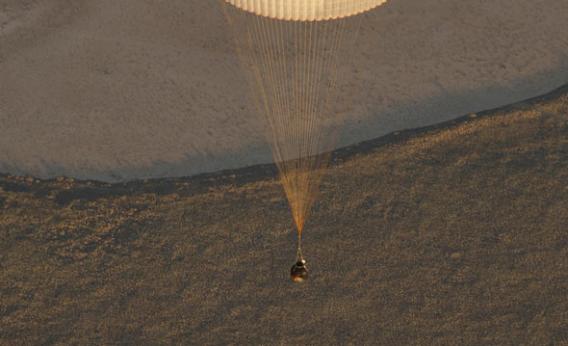Create a free profile to get unlimited access to exclusive videos, sweepstakes, and more!
Expedition 37 Returns to Earth After Five Months In Orbit

Last night, at 02:49 UTC on Nov. 11, 2013, three astronauts landed safely back on Earth after spending over five months in the International Space Station. Italian Luca Parmitano, American Karen Nyberg, and Russian Fyodor Yurchikhin are all back home â if Earth can said to be home to an astronaut.
The three came down in a Soyuz capsule, designated TMA-09M, the same capsule that brought them up to the ISS back in May 2013. They served on the station for 166 days.
The crew returned around the same time the GOCE satellite was re-entering Earthâs atmosphere. There was no danger from that, since they were happening at completely different locations on Earth, but it was interesting to have two such events going on at roughly the same time. I was thrilled to watch the Soyuz come down on NASAâs live video feed; the capsule dangling below the parachute as it descended, rescue helicopters circling, until it landed in the tall grass of a Kazakhstan field. Unfortunately, a short ridge blocked the view at the last second; I was hoping to see the landing rockets fire â these burn when the capsule is three meters above the ground to soften the impact of landing (and were put to good if somewhat scientifically inaccurate use in the movie âGravityâ).
The Expedition numbers assigned to the crews is a little confusing. In general, there are six astronauts on the ISS, and crews arrive and leave in groups of three. When a group of three leaves, closing the hatch behind them, the next Expedition officially begins. So usually, an Expedition begins with three crew, then goes up to six when three more astronauts arrive. That Expedition then ends when the first three leave, and the cycle begins anew. Usually that means that for brief periods of time only three crew are on the ISS.
This time, though, things were different. On May 13, 2013, Nyberg, Parmitano, and Yurchikhin, joined Expedition 36, already in progress, consisting of the three astronauts already on board: Pavel Vinogradov, Aleksandr Misurkin, and Chris Cassidy, who had been on ISS since March.
On Sep. 10, 2013, the latter three left the ISS, and Expedition 37 officially began with Parmitano, Nyberg, and Yurichikhin the only three on board. Two weeks later, on Sep. 25, 2013, Oleg Kotov, Sergey Ryazansky, and Michael Hopkins left Earth to join the ISS crew, and there were then six total Expedition 37 members.
Usually, the first three would leave before the next arrived. However, there was a change-up this time. On Nov. 7, 2013, another three-person crew arrived: Mikhail Tyurin, Rick Mastracchio, and Koichi Wakata. That brought the ISS crew to a total of nine!
Then, just a few days later on Nov. 10, Nyberg, Parmitano, and Yurchikhin climbed into their Soyuz and closed the hatch, leaving the six-crew members of the newly-begun Expedition 38 behind. Â
An interesting twist on this is that the Nov. 7 crew brought the Olympic torch with them. The Nov. 10 landing brought the torch back to Earth, having spent just a few days in space. If the crew cycle hadnât included nine people, then the torch wouldâve had to stay in space for much longer, several weeks. Thatâs apparently a happy coincidence; the decision to bring the torch up was made after it was decided to temporarily have nine people on ISS.
Anyway, Iâm glad to see the three space travelers back safely on the ground. I especially welcome Nyberg and Parmitano, who both did a great job taking pictures from space and putting them on Twitter; I never tire of the amazing stream of photos of our lovely world from above.
Welcome to back, Expedition 37.


























